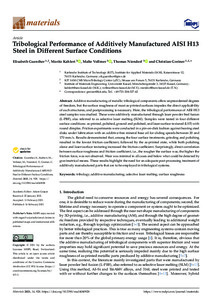| dc.date.accessioned | 2023-08-02T08:41:33Z | |
| dc.date.available | 2023-08-02T08:41:33Z | |
| dc.date.issued | 2021-02-16 | |
| dc.identifier | doi:10.17170/kobra-202308028558 | |
| dc.identifier.uri | http://hdl.handle.net/123456789/14963 | |
| dc.language.iso | eng | |
| dc.rights | Namensnennung 4.0 International | * |
| dc.rights.uri | http://creativecommons.org/licenses/by/4.0/ | * |
| dc.subject | tribology | eng |
| dc.subject | additive manufacturing | eng |
| dc.subject | selective laser melting | eng |
| dc.subject | surface roughness | eng |
| dc.subject.ddc | 620 | |
| dc.title | Tribological Performance of Additively Manufactured AISI H13 Steel in Different Surface Conditions | eng |
| dc.type | Aufsatz | |
| dcterms.abstract | Additive manufacturing of metallic tribological components offers unprecedented degrees of freedom, but the surface roughness of most as-printed surfaces impedes the direct applicability of such structures, and postprocessing is necessary. Here, the tribological performance of AISI H13 steel samples was studied. These were additively manufactured through laser powder bed fusion (L-PBF), also referred to as selective laser melting (SLM). Samples were tested in four different surface conditions: as-printed, polished, ground and polished, and laser-surface-textured (LST) with round dimples. Friction experiments were conducted in a pin-on-disk fashion against bearing steel disks under lubrication with an additive-free mineral base oil for sliding speeds between 20 and 170 mm/s. Results demonstrated that, among the four surface treatments, grinding and polishing resulted in the lowest friction coefficient, followed by the as-printed state, while both polishing alone and laser-surface texturing increased the friction coefficient. Surprisingly, direct correlation between surface roughness and friction coefficient, i.e., the rougher the surface was, the higher the friction force, was not observed. Wear was minimal in all cases and below what could be detected by gravimetrical means. These results highlight the need for an adequate post-processing treatment of additively manufactured parts that are to be employed in tribological systems. | eng |
| dcterms.accessRights | open access | |
| dcterms.creator | Guenther, Elisabeth | |
| dcterms.creator | Kahlert, Moritz | |
| dcterms.creator | Vollmer, Malte | |
| dcterms.creator | Niendorf, Thomas | |
| dcterms.creator | Greiner, Christian | |
| dcterms.extent | 10 Seiten | |
| dc.relation.doi | doi:10.3390/ma14040928 | |
| dc.subject.swd | Tribologie | ger |
| dc.subject.swd | Rapid Prototyping <Fertigung> | ger |
| dc.subject.swd | Selektives Laserschmelzen | ger |
| dc.subject.swd | Rauigkeit | ger |
| dc.type.version | publishedVersion | |
| dcterms.source.identifier | eissn:1996-1944 | |
| dcterms.source.issue | Issue 4 | |
| dcterms.source.journal | Materials | eng |
| dcterms.source.volume | Volume 14 | |
| kup.iskup | false | |
| dcterms.source.articlenumber | 928 | |


